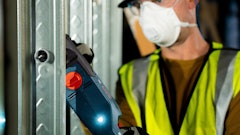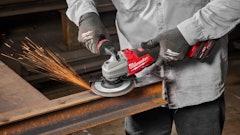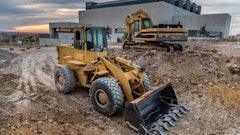Telescopic handlers are now an essential piece of equipment on most construction sites. Often referred to as the "swiss army knife" of the jobsite, telehandlers are becoming increasingly popular due to their flexibility to perform multiple tasks, from the beginning to the end of the project.
Loaded with features to improve productivity, telehandlers offer distinct advantages over other methods of material handling, such as mobile cranes. They are designed to be simple and intuitive to operate on the jobsite, where it is common for the telehandlers to be used for short periods of time throughout the day by a number of different operators.
Ensuring safety in this type of environment can be difficult, and there are a number of key considerations which contractors should be aware of.
Use properly trained and qualified operators. First and foremost, telehandlers should only be operated by properly trained and qualified personnel. The operator needs to be able to understand load charts, ground and weather conditions, weight and gravity center of the load, boom and angle indicators, and other key controls and functions to ensure the safe operation of the lift.
Choose the right telehandler for the job. Telehandlers are often deployed for jobs that exceed the capacity or capabilities of the lift, just because the machine is readily available. The results can be catastrophic. A properly trained operator should be able to identify the correct handler for the job, ensuring it has the capacity to lift the load, along with the necessary forward reach, terrain capabilities, suitable attachments and other features to complete the task safely.
Assess the conditions. Many telehandlers are specifically designed for use on rough terrain, however, it is still essential to carry out an assessment of the ground conditions before use. The operator should check for surface hazards, including obstructions, trenches, soft ground and standing water, to name a few. The operator should also check the load bearing ability of the ground to ensure it will support the total weight of the machine plus the load.
Use the right attachments. Telehandlers are available with an ever-increasing range of attachments, including forks, buckets, pole grapple carriages, grapple buckets, and concrete hoppers, all of which are designed to improve both efficiency and safety when performing specific tasks. Correct selection and use of telehandler attachments helps to ensure that loads are stable and secure during the lift, reducing the risk of accidents.
The operator should also take care to ensure that attachments are correctly fitted to the machine, and that they are used in accordance with the manufacturers’ guidelines.
Consider built-in safety features. While never a replacement for operator training, some telehandlers have been designed with a number of in-built safety features to help reduce the risk of accidents.
Operator visibility from the cab is critical to ensuring safe movement around the jobsite. Due to the position of the boom on certain telehandlers, operators could experience a blind spot behind the right-hand rear wheel. To overcome this, contractors could employ the services of a spotter, or alternatively, install a rear view camera system. Some telehandler manufacturers have specifically designed their handlers to provide full 360-degree operator visibility from the cab by changing the mounting position of the boom, eliminating the blind spot.
Telehandler operators are required to control a number of different functions simultaneously, which can result in the operator taking their hands off the steering wheel at times. Xtreme Manufacturing has designed an innovative "Y" frame sway, which can be controlled using the right forearm, with the right hand placed on the joystick. This releases the left hand to remain on the steering wheel at all times, giving the operator better overall control of the equipment.



















![Building Angled Sm Edit 6050b8d213f1b[1]](https://img.forconstructionpros.com/mindful/acbm/workspaces/default/uploads/2025/09/building-angled-sm-edit6050b8d213f1b1.Ygq5aAos3b.png?ar=16%3A9&auto=format%2Ccompress&crop=focalpoint&fit=crop&fp-x=0.53&fp-y=0.23&fp-z=2&h=135&q=70&w=240)